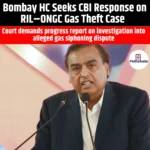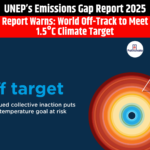Flash Floods in India
|
General Studies Paper I: Physical Geography, Important Geographical Phenomena |
Why in News?
Recently, flash floods have disrupted many parts of India. Sudden heavy rains triggered landslides and waterlogging in several states. In these events many people lost their homes and struggled for essentials. These events show how weather is changing and affecting daily life deeply.
Flash Floods in India: Rising Threat Through the Years
- India has seen several destructive flash floods over the past 15 years.
- In 2013, Uttarakhand witnessed one of the deadliest floods in Indian history. More than 5,700 people were presumed dead. Heavy rainfall combined with glacial bursts triggered the tragedy.
- In 2018, Kerala experienced severe flash floods after receiving 116% excess rainfall during the monsoon. Around 483 people lost their lives, and the state faced damage worth ₹30,000 crore.
- In 2021, Himachal Pradesh suffered from landslides and flash floods that killed over 300 people during the monsoon.
- In 2022, parts of Assam were underwater multiple times, affecting over 5 million people.
- In July 2023, Himachal Pradesh faced record-breaking rainfall. Over 250 people died due to landslides and flash floods. Roads and bridges were washed away, and key cities like Shimla and Manali remained cut off.
- In August 2023, Uttarakhand also experienced flash floods, which left over 100 dead and many missing.
- In 2024, Delhi witnessed unexpected urban flash floods in July after receiving 153 mm rain in just 24 hours—the highest in over 40 years.
- In July 2025, multiple regions in India once again faced flash flood emergencies. Parts of Himachal Pradesh, Uttarakhand, Assam, and Maharashtra reported heavy rain within a short period.
- The National Disaster Management Authority (NDMA) states that over 12% of India’s land is prone to floods, and flash floods now make up a growing share.
- Between 2010 and 2025, India has seen over 3,500 deaths due to flash flood-related events. Economic losses during this period cross ₹1.5 lakh crore.
|
What are Flash Floods?
|
Why are Flash Floods Increasing in India?
- Climate Change: India is facing unusual changes in its weather due to climate change. The Indian Meteorological Department (IMD) observed that monsoon rainfall is becoming more uneven and intense. In earlier decades, rain would fall steadily over weeks. Now, in many areas, the same amount of rain falls in just a few hours. In July 2023, Himachal Pradesh saw record rainfall of over 100 mm in just one hour. Rivers overflowed within minutes. Such extreme rainfall events have nearly doubled between 2000 and 2020, according to long-term IMD records.
- Unplanned Urban Growth: Cities are growing fast. Open lands, wetlands, and natural drains are being converted into buildings and roads. As a result, water has nowhere to go when heavy rain hits urban areas. The Central Ground Water Board also notes that many Indian cities have lost over 30% of their water-absorbing open spaces in the past two decades.
- Deforestation: In hilly states like Uttarakhand and Himachal Pradesh, trees are being cut for roads, buildings, and tourism projects. When forests are removed, the soil loses its strength. During heavy rain, loose soil slides down and blocks rivers or creates sudden pressure points. These lead to flash floods and landslides. The Forest Survey of India confirms that many Himalayan regions have seen significant forest loss between 2011 and 2021.
- Glacial Melting: Rising temperatures are melting glaciers faster in Himalayan regions. As glaciers melt, large lakes form behind natural dams of ice or rocks. These are called glacial lakes. If these natural dams break due to pressure or landslides, they release huge volumes of water instantly. This event is called a Glacial Lake Outburst Flood (GLOF).
Also Read: Floods in Rajasthan: Causes & Impact
Flash Flood Prone Areas in India
- Indo-Gangetic-Brahmaputra Plains: This large plain stretches across northern and eastern India. It includes states like Uttar Pradesh, Bihar, West Bengal, and Assam. Heavy rainfall during the monsoon causes rivers like the Ganga and Brahmaputra to overflow.
- Himalayan Region: The Himalayan states face the most intense flash floods in the country. Uttarakhand, Himachal Pradesh, and parts of Jammu and Kashmir are highly vulnerable. Steep slopes, melting glaciers, and deforestation make these areas unstable. When it rains heavily, water rushes down quickly and turns into violent floods.
- Coastal Region: States along the coast like Maharashtra, Tamil Nadu, Odisha, and Andhra Pradesh also experience flash floods. When heavy rain falls during cyclones or monsoon storms, cities flood within hours. Urban centres like Mumbai and Chennai see flash floods due to blocked drains and unplanned construction.
Government Preparedness to Tackle Flash Floods in India
- Early Warning Systems: The Indian Meteorological Department (IMD) has improved its forecasting systems. It now provides real-time weather updates and rainfall warnings. In 2021, IMD launched a flash flood guidance system for South Asia. This system alerts vulnerable districts up to six hours in advance.
- The National Remote Sensing Centre also uses satellite images to monitor rainfall and glacial lakes. This helps warn states like Uttarakhand, Sikkim, and Himachal Pradesh before floods happen.
- Disaster Management Authorities: The National Disaster Management Authority (NDMA) leads India’s response to floods. It works with state authorities and local teams. NDMA trains disaster response forces and organizes mock drills.
- In 2023, NDMA updated its flood management plan to cover flash floods and urban floods. The plan includes guidelines for early evacuation, relief camps, and rescue operations.
- State Disaster Response Forces (SDRFs) are now present in almost every flood-prone state.
- Infrastructure and Drainage Improvement: Urban floods are increasing due to poor drainage. The government has launched missions like the AMRUT scheme to improve city drainage systems. Cities like Mumbai and Chennai have started upgrading their stormwater drains. In 2022, the Ministry of Housing and Urban Affairs asked all cities to prepare flood action plans.
- Public Awareness: The government supports awareness drives to educate people in risk zones. Local volunteers are trained under community disaster programs. Schools, colleges, and village councils take part in these efforts. In recent years, more people know how to react when flash floods strike.
Also Read: WMO State of the Climate in Asia 2024 Report









